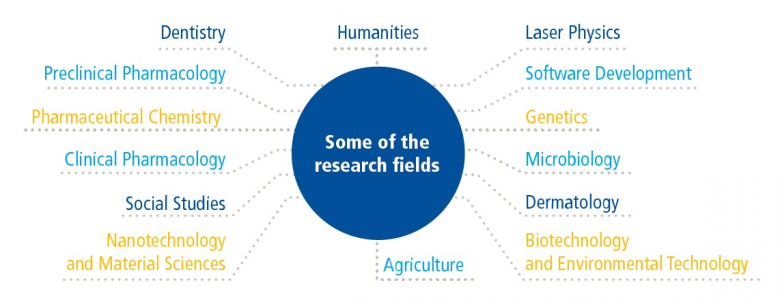Research at the University of Szeged
There are around 2,200 faculty members and researchers at the University of Szeged who are actively involved in national and international research projects. The University has 19 Doctoral Schools and numerous internationally renowned research groups. There are 16 research groups supported by the Hungarian Academy of Sciences (MTA) across 4 Faculties at the University.
Since 2011, 7 MTA Momentum research groups have also been operation and a number of research groups have been granted European Research Council support. Our researchers also participate in the National Brain Research Programme.
The University of Szeged is a Research University which strives for outstanding research, development and innovation. The university is also a Priority Higher Education Institution. This status is only granted to universities that offer high-level training and research capacities; achieve research results in a number of scientific fields that qualify them to play significant roles in implementing strategic national objectives; demonstrate outstanding improvements in international higher education rankings and where international student mobility is prominent.
Read more about R&D at University of Szeged
Research results are regularly published by University colleagues. In the past 5 years, there were approximately 25 000 publications in national, international journals and conference proceedings. The intellectual portfolio of the University comprises 37 patents and 16 know-hows. For example non-steroidal anti-inflammatory drugs, P2P communication, gel formulations suitable for cleaning pipes and pipe networks, laser tattoo removal, antitumor bacterial products, and a high-resolution optical microscope operating on the principle of image reconstruction. A number of these already been utilized through licence agreements and spin-off companies, established for this purpose. Numerous research projects are conducted in the Szeged Biological Research Centre and in the Albert Szent-Györgyi Health Centre and the ELI-ALPS Laser Research Centre.
Laser physicists from around the world and the laser physics school at the University of Szeged (in conjunction with Prague and Bucharest) come together to establish the Extreme Light Infrastructure. The Extreme Light Infrastructure Attosecond Light Pulse Source (ELI-ALPS) Laser Research Centre is one of the pillars of this infrastructure was built in Szeged and is one of the largest scientific investments in Europe, with support from the European Union amounting to over 70 billion HUF. The purpose of ELI-ALPS is to establish a unique, laser-based European user research facility where ultrashort laser pulses and light sources will be accessible for international researchers. ELI-ALPS’ Lasers will able to generate the shortest and greatest number of laser pulses per second so far. This allows researchers to examine elementary intramolecular physical processes and also provides unparalleled infrastructure to carry out basic and applied research on an ultrafast timescale for outstanding research results in biology, medicine and material sciences. There is a cooperation agreement between ELI-ALPS and the University resulting in the collaboration in the organisation of research projects and training programmes. The entire complex was opened in May 2017 and the facility will become fully operational in 2019.
A scientific industrial park is planned in a 80-hectare area surround the ELI-ALPS facility and is welcoming all start-up and successful businesses that could utilize the laser research centre and are drawn to Szeged by the inspirational atmosphere of the city. The Hungarian Molecular Medicine Centre of Excellence will also operate in the Science Park and will be established as a large scientific investment of the EU. An automotive industry competence centre may also be formed in conjunction with the University of Kecskemét. The first facilities are expected to open in 2019.

